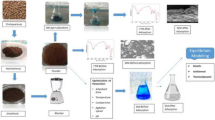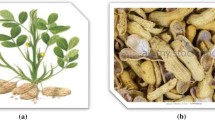Abstract
The objective of the present work is to investigate the extraction of copper from spent low temperature Shift catalyst using EDTA, as chelating agent and optimization of the parameters that influence the extraction of copper. Response surface methodology was applied for designing the experiment and to determine the optimal experimental conditions. Most influencing parameters such as concentration of EDTA, solid to liquid ratio and particle size of catalyst were optimized based on 3 factors 3 levels box behnken design which requires 15 run of experiments for designing a response surface. The high value of regression coefficient R 2 (0.981) indicates a good correlation between predicted and experimental response, which confirms the acceptability of the proposed model.The optimum conditions were found as—concentration of EDTA: 0.5889 M, solid to liquid ratio: 0.02 and particle size: 90 μm. Under these optimum conditions, the experimental value of extraction of copper was estimated as 94.5% which seems very close to predicted response.
Similar content being viewed by others
References
Jadhav, U. and Hocheng, H., A review of recovery of metals from industrial waste, J. Achiev. Mater., 2012, vol. 54, pp. 159–167.
Goel, S., Pant, K.K., and Nigam, K.D.P., Extraction of nickel from spent catalyst using fresh and recovered EDTA, J. Hazard. Mater., 2009, vol. 171, pp. 253–261.
Baba, A.A., Ghosh, M.K., Pradhan, S.R., Rao, D.S., Baral, A., and Adekola, F.A., Characterization and kinetic study on ammonia leaching of complex copper ore, T. Nonferr. Metal Soc., 2014, vol. 24, pp. 1587–1595.
Bingol, D. and Canbazoglu, M., Dissolution kinetics of malachite in sulphuric acid, Hydrometallurgy, 2004, vol. 72, pp. 159–165.
Habbache, N., Alane, N., Djerad, S., and Tifouti, L., Leaching of copper oxide with different acid solutions, Chem. Eng. J., 2009, vol. 152, pp. 503–508.
Drogui, P. and Mercier, G., Electrochemical treatment of bisphenol-A using response surface methodology, J. Appl. Electrochem., 2012, vol. 42, pp. 95–109.
Luis, S., Ferreira, C., Edward, R., Galv, E., Nei, W., Maria, C., Mauricio, J., Bittencourt, J., Andrade, D., Cristina, M., Cristina, I., Fontes, S., and Barros, B., Statistical designs and response surface techniques for the optimization of chromatographic systems, J. Chromatogr. A, 2007, vol. 1158, pp. 2–14.
Alaoui, A., Kacemi, K.E.L., Ass, K.E.L., and Kitane, S., Application of Box–Behnken design to determine the optimal conditions of reductive leaching of MnO2 from manganese mine tailings, Russ. J. Non-Ferrous Met., 2015, vol. 56, pp. 134–141.
Granholm, K., Harju, L., and Ivaska, A., Desorption of metal ions from kraft pulps, Part 1: Chelation of hardwood and softwood kraft pulp with EDTA, Bioresources, 2010, vol. 5, pp. 206–226.
Chikhi, M., Balaska, F., Benchaabi, R., Ayat, A., Maameche, K., and Meniai, A.H., Experimental study of coupling complexation-adsorption of Cu(II) on activated carbon, En. Procedia, 2011, vol. 6, pp. 284–291.
Raymond, H.M., Douglas, C.M., and Christine, M.A., Response Surface Methodology, 3rd ed., New Jersey: Wiley, 2009.
Tak, B., Tak, B., Kim, Y., Park, Y., Yoon, Y., and Min, G., Optimization of color and COD removal from livestock wastewater by electrocoagulation process: Application of Box–Behnken design (BBD), J. Ind. Eng. Chem., 2015, vol. 28, pp. 307–315.
Moghaddam, M.G. and Khajeh, M., Comparison of response surface methodology and artificial neural network in predicting the microwave-assisted extraction procedure to determine zinc in fish muscles, Food Nutrition Sci., 2011, vol. 2, pp. 803–808.
Ghazala, I., Sila, A., Frikha, F., and Driss, D., Antioxidant and antimicrobial properties of water soluble polysaccharide extracted from carrot peels byproducts, J. Food. Sci. Technol., 2015, vol. 52, pp. 6953–6965.
Khajeh, M. and Sanchooli, E., Synthesis of ion-selective imprinted polymer for manganese removal from environmental water, Polym. Bull., 2011, vol. 67, pp. 413–425.
Salam, A., Rose, M., Kamarudin, A., Jubri, Z., and Ramli, Z., Response surface methodology for optimizing zeolite Na-A synthesis, Arab. J. Sci. Eng., 2013, vol. 38, pp. 1713–1720.
Division, P.T., Optimization of process variables for phyllanthin extraction from Phyllanthus amarus leaves by supercritical fluid using a Box–Behnken experimental design followed by HPLC identification, Acta Pharm., 2013, vol. 63, pp. 193–207.
Nikrooz, B. and Zandrahimi, M., Optimization of process variables and corrosion properties of a multi layer silica sol gel coating on AZ91D using the Box–Behnken design, J. Sol-Gel Sci. Technol., 2011, vol. 59, pp. 640–649.
Chomsamutr, K. and Jongprasithporn, S., Optimization parameters of tool life model using the Taguchi approach and response surface methodology, Int. J. Comp. Sci. Iss., 2012, vol. 9, pp. 120–125.
Author information
Authors and Affiliations
Corresponding author
Additional information
The article is published in the original.
About this article
Cite this article
Sharma, S., Dutta, N.N. & Agrawal, G.K. Optimization of copper extraction from spent LTS catalyst (CuO–ZnO–Al2O3) using chelating agent: Box-behnken experimental design methodology. Russ. J. Non-ferrous Metals 58, 22–29 (2017). https://doi.org/10.3103/S1067821217010102
Received:
Published:
Issue Date:
DOI: https://doi.org/10.3103/S1067821217010102




